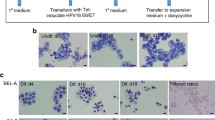Summary
Three continuous human cell lines, designated KMOE, derived from a patient with acute erythremia (Di Guglielmo's disease) are reported. The cell lines are the cultures of (1) bone marrow cells, (2) peripheral blood cells, and (3) cells from a tumor developed into an athymic nude mouse after transplantation of the cultured bone marrow cells. Cells of all three lines show morphology of immature erythroblast and have i(17q) marker chromosome. They are negative for both Philadelphia chromosome and Epstein-Barr virus nuclear antigen. Although all KMOE cells in suspension culture are benzidine-negative, benzidine-positive cells are found within colonies formed in semi-solid culture media. The relative number of colonies with benzidine-positive cells is increased when sodium butyrate is added to the culture.
The KMOE cell lines are human erythroid cell lines with erythroblastic morphology and still retain their tendency for differentiation.
Similar content being viewed by others
References
Andersson LC, Jokinen M, Gahmberg CG (1979a) Induction of erythroid differentiation in the human leukaemia cell line K562. Nature 278:364–365
Andersson LC, Nilsson K, Gahmberg CG (1979b) K562-a human erythroleukemic cell line. Int J Cancer 23:143–147
Friend C, Scher W, Holland JG, Sato T (1971) Hemoglobin synthesis in murine virus-induced leuke cells in vitro: Stimulation of erythroid differentiation by dimethyl sulfoxide. Proc Natl Acad Sci USA 68:378–381
Gahmberg CG, Jokinen M, Andersson LC (1978) Expression of the major sialoglycoprotein (Glycophorin) on erythroid cells in human bone marrow. Blood 52:379–387
Ikawa Y, Inoue Y, Aida M, Kameji R, Shibata C, Sugano H (1976) Phenotypic variants of differentiation-inducible Friend leukemia lines: Isolation and correlation between inducibility and virus release. Bibl Haematol 43:37–47
Lozzio CB, Lozzio BB (1975) Human chronic myelogenous leukemia cellline with positive Philadelphia chromosome. Blood 45:321–334
Lozzio CB, Lozzio BB, Machado FA, Fuhr JE, Lair SV, Bamberger EG (1979) Effects of sodium butyrate on human chronic myelogenous leukaemia cell line K562. Nature 281:709–710
Orkin SH, Harosi FI, Leder P (1975) Differentiation in erythroleukemic cells and their somatic hybrids. Proc Natl Acad Sci USA 72:98–102
Rutherford TR, Weatherall DJ (1979) Deficient heme synthesis as the cause of noninducibility of hemoglobin synthesis in a Friend erythroleukemia cell line. Cell 16:415–423
Author information
Authors and Affiliations
Additional information
Supported in part by a Grant-in-Aid for Cancer Research from the Ministry of Public Health and Welfare of Japan
Rights and permissions
About this article
Cite this article
Okano, H., Okamura, J., Yagawa, K. et al. Human erythroid cell lines derived from a patient with acute erythremia. J Cancer Res Clin Oncol 102, 49–55 (1981). https://doi.org/10.1007/BF00410534
Received:
Accepted:
Issue Date:
DOI: https://doi.org/10.1007/BF00410534




